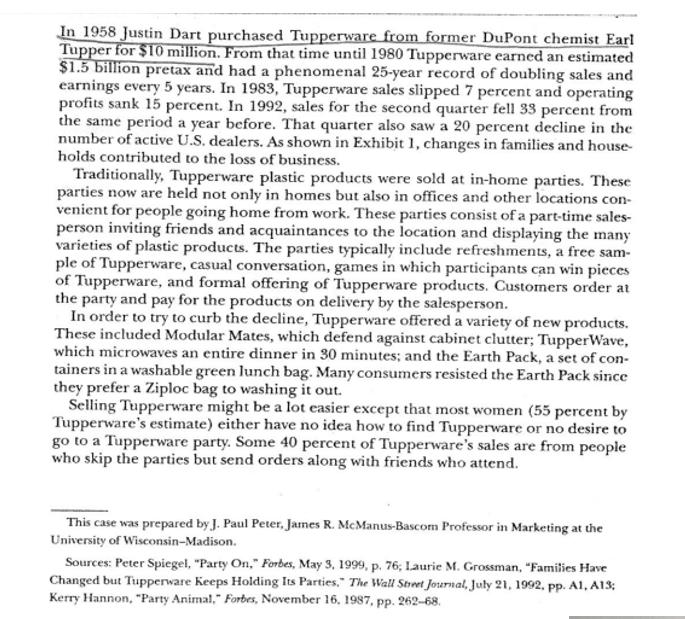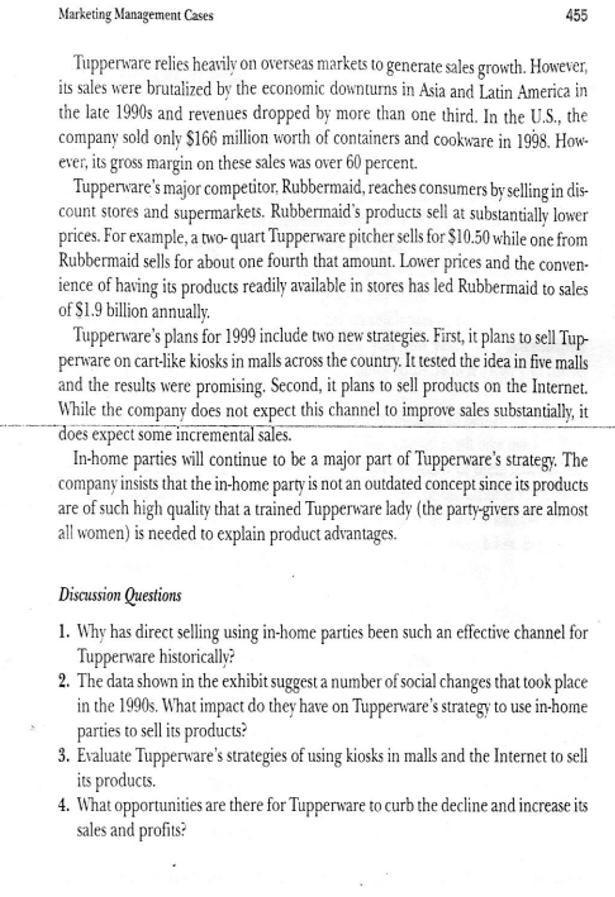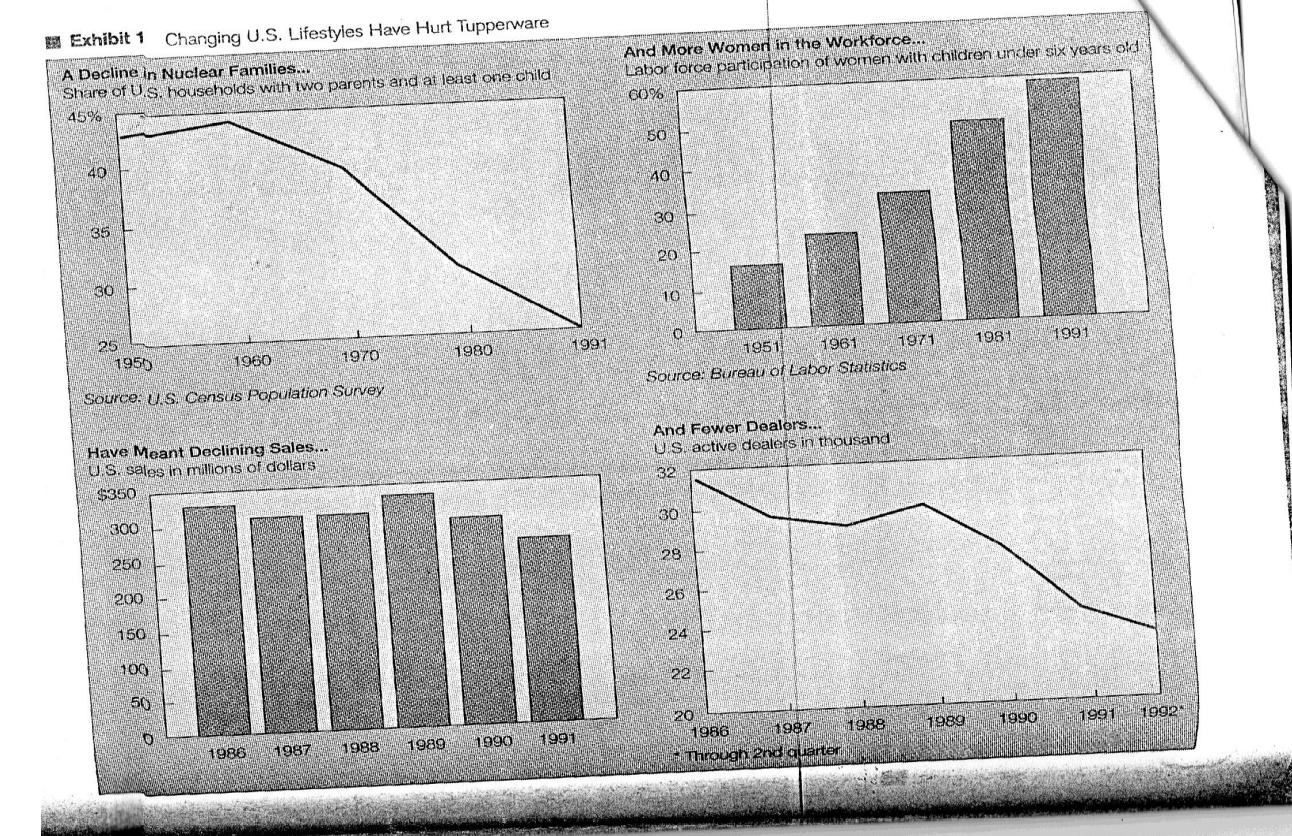Answered step by step
Verified Expert Solution
Question
1 Approved Answer
In 1958 Justin Dart purchased Tupperware from former DuPont chemist Earl Tupper for $10 million. From that time until 1980 Tupperware earned an estimated



In 1958 Justin Dart purchased Tupperware from former DuPont chemist Earl Tupper for $10 million. From that time until 1980 Tupperware earned an estimated $1.5 billion pretax and had a phenomenal 25-year record of doubling sales and earnings every 5 years. In 1983, Tupperware sales slipped 7 percent and operating profits sank 15 percent. In 1992, sales for the second quarter fell 33 percent from the same period a year before. That quarter also saw a 20 percent decline in the number of active U.S. dealers. As shown in Exhibit 1, changes in families and house- holds contributed to the loss of business. Traditionally, Tupperware plastic products were sold at in-home parties. These parties now are held not only in homes but also in offices and other locations con- venient for people going home from work. These parties consist of a part-time sales- person inviting friends and acquaintances to the location and displaying the many varieties of plastic products. The parties typically include refreshments, a free sam- ple of Tupperware, casual conversation, games in which participants can win pieces of Tupperware, and formal offering of Tupperware products. Customers order at the party and pay for the products on delivery by the salesperson. In order to try to curb the decline, Tupperware offered a variety of new products. These included Modular Mates, which defend against cabinet clutter; TupperWave, which microwaves an entire dinner in 30 minutes; and the Earth Pack, a set of con- tainers in a washable green lunch bag. Many consumers resisted the Earth Pack since they prefer a Ziploc bag to washing it out. Selling Tupperware might be a lot easier except that most women (55 percent by Tupperware's estimate) either have no idea how to find Tupperware or no desire to go to a Tupperware party. Some 40 percent of Tupperware's sales are from people who skip the parties but send orders along with friends who attend. This case was prepared by J. Paul Peter, James R. McManus-Bascom Professor in Marketing at the University of Wisconsin-Madison. Sources: Peter Spiegel, "Party On," Forbes, May 3, 1999, p. 76; Laurie M. Grossman, "Families Have Changed but Tupperware Keeps Holding Its Parties." The Wall Street Journal, July 21, 1992, pp. A1, A13; Kerry Hannon, "Party Animal," Forbes, November 16, 1987, pp. 262-68. Marketing Management Cases 455 Tupperware relies heavily on overseas markets to generate sales growth. However, its sales were brutalized by the economic downturns in Asia and Latin America in the late 1990s and revenues dropped by more than one third. In the U.S., the company sold only $166 million worth of containers and cookware in 1998. How- ever, its gross margin on these sales was over 60 percent. Tupperware's major competitor, Rubbermaid, reaches consumers by selling in dis- count stores and supermarkets. Rubbermaid's products sell at substantially lower prices. For example, a two-quart Tupperware pitcher sells for $10.50 while one from Rubbermaid sells for about one fourth that amount. Lower prices and the conven- ience of having its products readily available in stores has led Rubbermaid to sales of $1.9 billion annually. Tupperware's plans for 1999 include two new strategies. First, it plans to sell Tup- perware on cart-like kiosks in malls across the country. It tested the idea in five malls and the results were promising. Second, it plans to sell products on the Internet. While the company does not expect this channel to improve sales substantially, it does expect some incremental sales. In-home parties will continue to be a major part of Tupperware's strategy. The company insists that the in-home party is not an outdated concept since its products are of such high quality that a trained Tupperware lady (the party-givers are almost all women) is needed to explain product advantages. Discussion Questions 1. Why has direct selling using in-home parties been such an effective channel for Tupperware historically? 2. The data shown in the exhibit suggest a number of social changes that took place in the 1990s. What impact do they have on Tupperware's strategy to use in-home parties to sell its products? 3. Evaluate Tupperware's strategies of using kiosks in malls and the Internet to sell its products. 4. What opportunities are there for Tupperware to curb the decline and increase its sales and profits? Exhibit 1 Changing U.S. Lifestyles Have Hurt Tupperware A Decline in Nuclear Families... Share of U.S. households with two parents and at least one child 45% 40 35 30- 25 1950 Source: U.S. Census Population Survey Have Meant Declining Sales... U.S. sales in millions of dollars $350 300 250 200 150 1960 100 50 I 10 1986 1970 1987 1988 1989 1980 1990 1991 1991 And More Women in the Workforce.... Labor force participation of women with children under six years old. 60% 50 40 30 20 10 0 1961 1951 Source: Bureau of Labor Statistics And Fower Dealers.... U.S. active dealers in thousand 32 30 28 26 24 22 20 1986 1987 Through 2nd quarter MENDE 1971 1988 1989 1981 1990 1991 1991 1992*
Step by Step Solution
There are 3 Steps involved in it
Step: 1
Here are the key points and discussion questions regarding the Tupperware case study 1 Why has direct selling using inhome parties been such an effect...
Get Instant Access to Expert-Tailored Solutions
See step-by-step solutions with expert insights and AI powered tools for academic success
Step: 2

Step: 3

Ace Your Homework with AI
Get the answers you need in no time with our AI-driven, step-by-step assistance
Get Started


